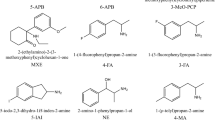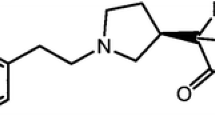Abstract
Excellent reproducibility of chiral capillary electrophoresis for methamphetamine (MA) and its related compounds was obtained using a chemically modified capillary having diol groups. The data were compared with those using an untreated fused-silica capillary and a poly(vinyl alcohol) (PVA)-coated capillary. For five replicate analyses of a standard mixture, relative standard deviations (RSDs) of the migration times of analytes with diol or PVA-coated capillaries were less than 0.1%, which were lower than those obtained with an untreated fused-silica capillary (ca. 0.4%). The diol capillary gave reproducible migration times especially in analyses of real samples, such as crude human urine. In the analyses of five spiked urine samples, the RSD values of migration times of analytes with the diol capillary were not greater than 0.14%, which were much lower than those obtained with the PVA-coated capillary (ca. 1.5%). The proposed method was successfully used for chiral analyses of actual urine samples of MA addicts.
Similar content being viewed by others
References
Takayama N, Hayakawa K (2005) Amphetamines and their metabolites. In: Suzuki O, Watanabe K (eds) Drugs and poisons in humans: a handbook of practical analysis. Springer, Berlin Heidelberg New York, pp 171–185
Fujii H, Hara K, Kageura M, Kashiwagi M, Matsusue A, Kubo S (2009) High throughput chiral analysis of urinary amphetamines by GC-MS using a short narrow-bore capillary column. Forensic Toxicol 27:75–80
Shima N, Katagi M, Kamata H, Zaitsu K, Kamata T, Miki A, Tsuchihashi H, Sakuma T, Nemoto N (2008) Conjugates of p-hydroxymethamphetamine and 4-hydroxy-3-methoxymethamphetamine in blood obtained from methamphetamine and 3,4-methylenedioxymethamphetamine users: analysis by LC-MS-MS. Forensic Toxicol 26:58–65
Chinaka S, Tanaka S, Takayama N, Komai K, Ohshima T, Ueda K (2000) Simultaneous chiral analysis of methamphetamine and related compounds by capillary electrophoresis. J Chromatogr B 749:111–118
Iio R, Chinaka S, Takayama N, Hayakawa K (2005) Simultaneous chiral analysis of methamphetamine and related compounds by capillary electrophoresis/mass spectrometry using anionic cyclodextrin. Anal Sci 21:15–19
Juvancz Z, Kendrovics RB, Ivanyi R, Szente L (2008) The role of cyclodextrins in chiral capillary electrophoresis. Electrophoresis 29:1701–1712
Chinaka S, Iio R, Tanaka S, Takayama N, Komai K, Ohshima T, Ueda K (2003) Simultaneous chiral determination of methamphetamine and its metabolites in urine by capillary electrophoresis using two internal standards. Jpn J Forensic Toxcol 21:29–37
Chinaka S, Iio R, Tanaka S, Takayama N, Hayakawa K (2004) Development of chiral screening test method of methamphetamine and its metabolites in urine by capillary electrophoresis (in Japanese). Jpn J Sci Technol Iden 9:103–111
Iio R, Chinaka S, Tanaka S, Takayama N, Hayakawa K (2003) Simultaneous chiral determination of methamphetamine and its metabolites in urine by capillary electrophoresismass spectrometry. Analyst 128:646–650
Iio R, Chinaka S, Takayama N, Hayakawa K (2005) Simultaneous chiral analysis of methamphetamine and its metabolites by capillary electrophoresis/mass spectrometry with direct injection of urine. J Health Sci 51:693–701
Iwata YT, Kanamori T, Ohmae Y, Tsujikawa K, Inoue H, Kishi T (2003) Chiral analysis of amphetamine-type stimulants using reversed-polarity capillary electrophoresis/positive ion electrospray ionization tandem mass spectrometry. Electrophoresis 24:1770–1776
Minnoor E, Liu Y, Pietrzyk DJ (2000) Applications of a sulfonated-polymer wall-modified open-tubular fused-silica capillary in capillary zone electrophoretic separations. J Chromatogr A 884:297–309
Bendahl L, Hansen SH, Gammelgaard B (2001) Capillaries modified by noncovalent anionic polymer adsorption for capillary zone electrophoresis, micellar electrokinetic capillary chromatography and capillary electrophoresis mass spectrometry. Electrophoresis 22:2565–2573
Chen WH, Liu CY (1999) Macrocyclic polyamine as a selective modifier in a bonded-phase capillary column for the electrophoretic separation of aromatic acids. J Chromatogr A 848:401–416
Kodama S, Yamamoto A, Terashima H, Honda Y, Taga A, Honda S (2005) A sulfonated capillary that gives reproducible migration times for capillary zone electrophoresis and micellar electrokinetic chromatography. Electrophoresis 26:4070–4078
Taga A, Nishi T, Honda Y, Sato A, Terashima H, Suzuki K, Kodama S, Boki K (2007) High speed and reproducible analysis of nitrosamines by capillary electrophoresis with a sulfonated capillary. J Oleo Sci 56:429–434
Fritz JS (2000) Recent developments in the separation of inorganic and small organic ions by capillary electrophoresis. J Chromatogr A 884:261–275
Schmitt-Kopplin P, Garmash AV, Kudryavtsev AV, Menzinger F, Perminova I, Hertkorn N, Freitag D, Petrosyan VS, Kettrup A (2001) Quantitative and qualitative precision improvements by effective mobility-scale data transformation in capillary electrophoresis analysis. Electrophoresis 22: 77–87
Shao X, Shen Y, O’Neill K, Lee ML (1999) Capillary electrophoresis using diol-bonded fused-silica capillaries. J Chromatogr A 830:415–422
Pesek JJ, Matyska MT, Mauskar L (1997) Separation of proteins and peptides by capillary electrochromatography in diol- and octadecyl-modified etched capillaries. J Chromatogr A 763:307–314
Ikuta N, Sakamoto H, Yamada Y, Hirokawa T (1999) Numerical simulation for capillary electrophoresis II. Relaxation effect of potential gradient in capillary zone electrophoresis. J Chromatogr A 838:19–29
Chinaka S, Iio R, Takayama N, Kodama S, Hayakawa K (2006) Chiral capillary electrophoresis of amphetamine-type stimulants. J Health Sci 52:649–654
Author information
Authors and Affiliations
Corresponding author
Rights and permissions
About this article
Cite this article
Iwamuro, Y., Iio-Ishimaru, R., Chinaka, S. et al. Reproducible chiral capillary electrophoresis of methamphetamine and its related compounds using a chemically modified capillary having diol groups. Forensic Toxicol 28, 19–24 (2010). https://doi.org/10.1007/s11419-009-0086-x
Received:
Accepted:
Published:
Issue Date:
DOI: https://doi.org/10.1007/s11419-009-0086-x




